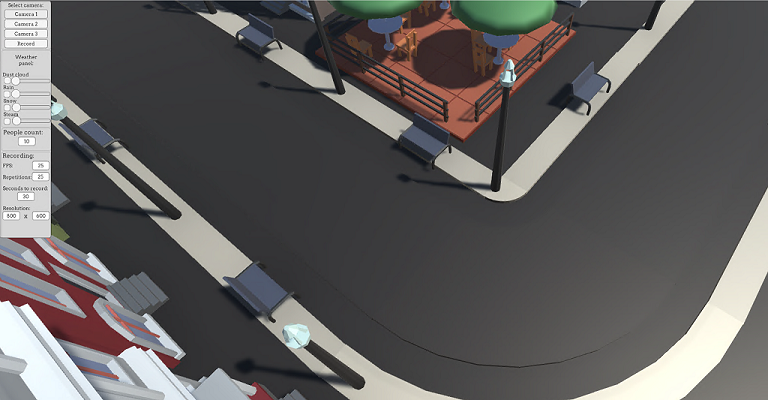Article
Application of Crowd Simulations in the Evaluation
of Tracking Algorithms
Michał Staniszewski1,∗
, Paweł Foszner 1, Karol Kostorz 1, Agnieszka Michalczuk 1,
Kamil Wereszczy nski1, Michał Cogiel1, Dominik Golba1, Konrad Wojciechowski2 and
Andrzej Polański1
1
Department of Computer Graphics, Vision and Digital Systems, Faculty of Automatic Control, Electronics
and Computer Science, Silesian University of Technology, Akademicka 2A, 44-100 Gliwice, Poland.
pawel.foszner@polsl.pl (P.F.); kostorz.karol@gmail.com (K.K.); agnieszka.michalczuk@polsl.pl (A.M.);
kamil.wereszczynski@polsl.pl (K.W.); michal.cogiel@polsl.pl (M.C.); dominik.golba@polsl.pl (D.G.);
andrzej.polanski@polsl.pl (A.P.)
2
Polish-Japanese Academy of Information Technology, Koszykowa 86, 02-008 Warszawa, Poland.
konrad.wojciechowski@polsl.pl
* Correspondence: michal.staniszewski@polsl.pl; Tel.: +48-32-237-26-69
Received: date; Accepted: date; Published: date
Abstract: Tracking and action-recognition algorithms are currently widely used in video surveillance,
monitoring urban activities and in many other areas. Their development highly relies on
benchmarking scenarios, which enable reliable evaluations/improvements of their efficiencies.
Presently, benchmarking methods for tracking and action-recognition algorithms rely on manual
annotation of video databases, prone to human errors, limited in size and time-consuming.
Here, using gained experiences, an alternative benchmarking solution is presented, which employs
methods and tools obtained from the computer-game domain to create simulated video data with
automatic annotations. Presented approach highly outperforms existing solutions in the size of the
data and variety of annotations possible to create. With proposed system, a potential user can generate
a sequence of random images involving different times of day, weather conditions, and scenes for use
in tracking evaluation. In the design of the proposed tool, the concept of crowd simulation is used
and developed. The system is validated by comparisons to existing methods.
Keywords: tracking multiple objects; visual object tracking; urban data collection; video acquisition;
image processing; crowd simulations; multiple people tracking; benchmark
Use our work
MDPI and ACS Style
Staniszewski, M.; Foszner, P.; Kostorz, K.; Michalczuk, A.; Wereszczyński, K.; Cogiel, M.; Golba, D.; Wojciechowski, K.; Polański, A.
Application of Crowd Simulations in the Evaluation of Tracking Algorithms. Sensors 2020, 20, 4960.
AMA Style
Staniszewski M, Foszner P, Kostorz K, Michalczuk A, Wereszczyński K, Cogiel M, Golba D, Wojciechowski K, Polański A.
Application of Crowd Simulations in the Evaluation of Tracking Algorithms. Sensors. 2020; 20(17):4960.
Chicago/Turabian Style
Staniszewski, Michał; Foszner, Paweł; Kostorz, Karol; Michalczuk, Agnieszka; Wereszczyński, Kamil; Cogiel, Michał; Golba, Dominik; Wojciechowski, Konrad; Polański, Andrzej.
2020. "Application of Crowd Simulations in the Evaluation of Tracking Algorithms." Sensors 20, no. 17: 4960.
@article{staniszewski2020application,
author={Staniszewski, Micha{\l} and Foszner, Pawe{\l} and Kostorz, Karol and Michalczuk, Agnieszka and Wereszczy{\'n}ski, Kamil and Cogiel, Micha{\l} and Golba, Dominik and Wojciechowski, Konrad and Pola{\'n}ski, Andrzej},
journal={Sensors},
volume={20},
number={17},
pages={4960},
year={2020},
publisher={Multidisciplinary Digital Publishing Institute}
}
Software
 Figure 1.
Figure 1. Screenshot of Unity Crowd Simulation Main Window
Sample Data


 Figure 2.
Figure 2. Example of crowd simulations given in three different views - three different cameras.


 Figure 3.
Figure 3. Example of crowd simulations for three different weather conditions: rain, snow and steam


 Figure 4.
Figure 4. Example of crowd simulations for 10, 50 and 100 pedestrians walking on the simulation in one camera view used in analysis of influence of crowd density on tracking algorithms.
References
Myśliwiec, T. Symulator tłumu umożliwiający weryfikację algorytmów śledzenia obiektów. Politechnika Śląska

